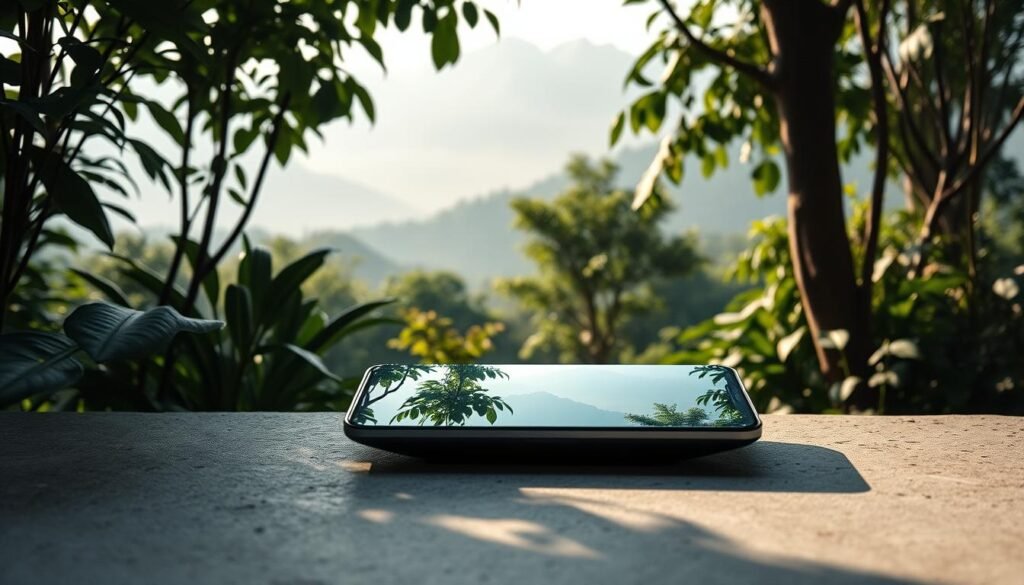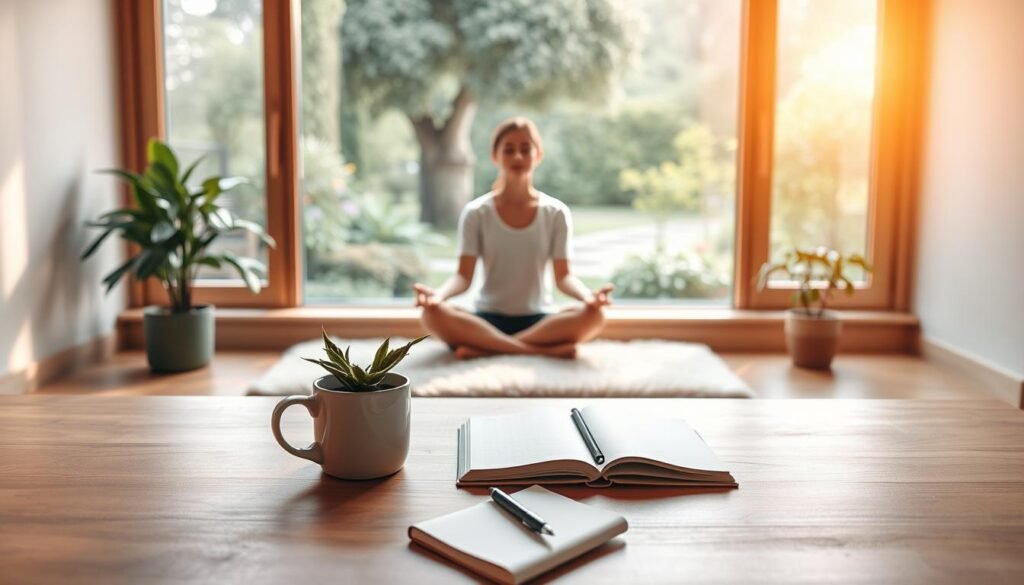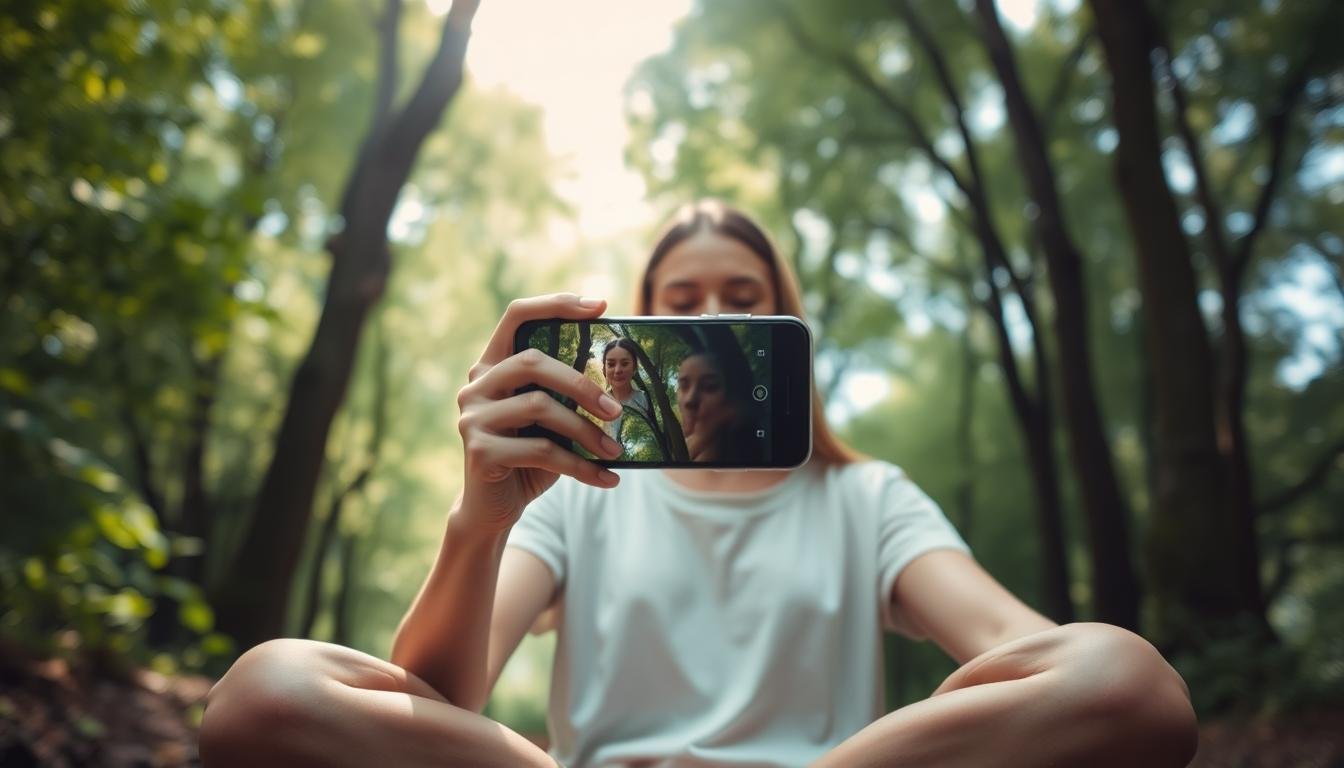Can Technology Really Make You More Mindful?
Many assume digital tools and inner peace can’t coexist. But what if our screens could strengthen focus instead of fracturing it? Jay Vidyarthi, a leading voice in mindful design, compares resisting tech to trying to stop breathing—it’s part of being human. The guilt around relying on devices often overshadows their potential to enhance awareness when used thoughtfully.
This section rethinks the idea that smartphones and apps inherently sabotage presence. Like thoughts during meditation, gadgets aren’t enemies to eliminate. They’re extensions of our natural curiosity and connection. The real challenge lies in shifting from passive scrolling to intentional engagement.
Modern apps now offer guided breathing exercises, focus timers, and gratitude journals. These tools don’t replace traditional practices—they meet people where they already spend time. Instead of preaching digital detoxes, we’ll explore how blending tech with mindfulness creates a sustainable path forward for busy lives.
Key Takeaways
- Digital devices aren’t inherently distractions—they reflect how we choose to engage with them
- Guilt about tech use often stems from unrealistic expectations of total disconnection
- Purposeful app selection can support daily awareness practices
- Mindfulness involves working with reality, not fighting against modern habits
- Balance comes from conscious usage patterns, not complete avoidance
Understanding the Intersection of Technology and Mindfulness
In a world quick to demonize screens, we miss their hidden ability to deepen our connection to the present. Digital tools act like mirrors—they reflect how we choose to engage. A vibrating phone isn’t inherently disruptive, just as a hammer isn’t automatically destructive. It’s about conscious application rather than blind consumption.

Exploring the Dual Nature of Tech
Studies reveal texting drivers make 20 times more errors than focused ones—yet mindful teens resist this urge. This contrast shows devices amplify existing habits. Workplace research proves employees practicing awareness techniques perform better in complex tasks. Our gadgets magnify both focus and fragmentation, depending on our mental state.
How Digital Distractions Influence Our Attention
Endless notifications trick the mind into craving constant updates, creating a false sense of urgency. The internet feeds our desire for instant answers, making uncertainty feel uncomfortable. But here’s the twist: resisting tech often backfires. Accepting it as part of modern life helps build healthier patterns. Instead of fighting distractions, we learn to spot when they hijack our attention.
Like a kitchen knife, technology serves multiple purposes. It can slice vegetables or cause harm—the difference lies in awareness. By recognizing this duality, we reclaim power over our digital experiences.
Can Technology Really Make You More Mindful?
Our relationship with devices often feels like a tug-of-war between focus and distraction. But what if we stopped viewing screens as invaders and started seeing them as natural extensions of human creativity? Just as beavers shape rivers with dams, we mold digital landscapes through apps and interfaces.

Setting Clear Intentions for a Healthier Digital Life
Start by asking why you pick up your phone. Is it to connect meaningfully or escape discomfort? A 2023 University of Washington study found people who set daily usage goals reduced mindless scrolling by 37%. Try these steps:
- Define three core purposes for your devices
- Schedule specific times for social checks
- Use app limits as training wheels, not handcuffs
Embracing Technology as an Extension of Human Nature
Consider how crows use sticks to retrieve food—a perfect example of tool use in nature. Our smartphones serve similar survival purposes: finding food, building community, sharing knowledge. The key difference lies in scale, not essence.
When we accept gadgets as part of our evolutionary journey, guilt transforms into curiosity. Track your screen time not to judge, but to understand your digital ecosystem. What patterns serve your well-being? Which ones drain energy?
Practical How-To Tips for Mindful Tech Use
What if your phone became a mindfulness tool rather than a distraction? Start by redefining your relationship with devices through intentional habits. One user found freedom by checking messages once daily and social platforms weekly—a shift that evolved into two-hour meditation sessions over two years.

Establishing a Digital Detox Routine
Jay Vidyarthi’s approach turns scrolling into conscious practice: “Savor content like fine chocolate—slowly and without guilt.” Begin with these steps:
| Step | Action | Benefit |
|---|---|---|
| 1 | Delete time-sucking apps | Reduces decision fatigue |
| 2 | Set device-free zones | Strengthens focus |
| 3 | Pair app use with breath checks | Links tech to awareness |
Try a 15-minute “tech meditation” daily: open one app mindfully, notice physical sensations, and exit when focus wavers. This builds self-awareness without strict bans.
Track progress using built-in screen time features. One parent reduced phone pickups by 40% in three weeks through evening device lockups. Remember—consistency beats perfection. Even five minutes of intentional app use trains your attention muscle.
Mindfulness, Mental Health, and Digital Consumption
The pandemic revealed how deeply our screens shape emotional landscapes. During lockdowns, 45% of adults reported mental health declines—not just from isolation, but from how we used devices. Research shows excessive scrolling often masks unresolved stress, creating cycles of emotional numbness and reactive browsing.

Balancing Screen Time with Meditation and Reflection
Harvard studies found that 12 minutes of daily meditation counteracts screen fatigue better than complete tech avoidance. Try this approach:
| Digital Habit | Mindful Alternative | Health Impact |
|---|---|---|
| Morning scroll | 5-minute breath focus | Reduces anxiety |
| Lunchtime emails | Gratitude journaling | Boosts mood |
| Late-night streaming | Body scan practice | Improves sleep |
One teacher reduced her social media use by 70% using “app mindfulness checks”: pausing to notice physical sensations before opening platforms. “It revealed how often I reached for my phone when feeling lonely,” she shared.
Addressing Social Media and Its Impact on Emotions
Platforms trigger emotions through designed rewards—likes activate dopamine pathways like slot machines. A 2022 study found comparing lifestyles online increases depression risk by 32%. But awareness changes everything.
“Notice when envy arises during scrolling—it’s data, not destiny. Breathe through the urge to compare.”
Practical fix: Curate feeds to include accounts that inspire rather than deplete. Pair every 30 minutes of browsing with three minutes of focused breathing. This builds emotional resilience while keeping digital connections alive.
Integrating Mindful Practices into Your Daily Tech Routine
Your scrolling habits hold hidden potential for cultivating presence. With strategic tweaks, device interactions become opportunities for self-discovery rather than autopilot reactions. Start by auditing your app ecosystem—which tools nourish your growth versus drain attention?
Utilizing Mindfulness Apps and Tools
Research shows 78% of consistent app users report better stress management. But effectiveness depends on intentional selection. Consider this comparison:
| Tool Type | Best Use | Potential Pitfall |
|---|---|---|
| Guided meditation apps | Morning routines | Overloading with sessions |
| Digital journals | Evening reflections | Perfectionism in entries |
| Focus timers | Work sessions | Ignoring natural rhythms |
Try pairing specific apps with daily activities. A teacher shared: “I use a breathing tool during commute red lights—turns frustration into centering moments.” This bridges tech use with real-world awareness.
Balance requires honest self-assessment. Delete one distracting app weekly while adding one that supports your goals. Track how each tool affects your relationships and energy levels. As psychologist Linda Stone notes:
“Quality of attention determines quality of life—choose apps that deepen rather than fragment your focus.”
End each screen session with a three-breath check-in. This simple habit builds awareness between digital interactions. Remember—the right tools should feel like helpful companions, not demanding bosses.
Real Life Examples and Evidence-Based Insights
Stories from daily life reveal surprising truths about our tech habits. Take Mark, a hiker who fractured both ankles while replying to work emails on uneven terrain. His experience shows how distraction impacts physical safety—not just mental focus. “I thought I could multitask,” he admitted. “Now I schedule phone checks only when stationary.”
Learning from Personal Stories and Case Studies
During lockdowns, Sarah transformed her relationship with devices through radical minimalism. Checking her phone once daily and social media weekly freed up two hours for meditation practice. “At first, I felt FOMO,” she shared. “But within months, my anxiety levels dropped by 60%.”
Research Findings on Digital Minimalism and Presence
The World Economic Forum reports 75% of companies will adopt advanced technologies like AI by 2028. This rapid change makes mindfulness skills essential for navigating modern work environments. Consider these research-backed insights:
| Mindfulness Benefit | Tech Adoption Challenge | Impact on Society |
|---|---|---|
| Reduced stress | Data overload | +42% productivity |
| Improved focus | Notification fatigue | -35% errors |
| Emotional balance | 24/7 connectivity | +28% job satisfaction |
Generational data reveals varied approaches—Gen Z spends 30% less time on social apps than millennials but faces higher pressure to maintain online personas. Forward-thinking firms now implement “tech curfews” and meditation stipends, recognizing that conscious device use boosts both well-being and bottom lines.
Conclusion
Every notification ping offers a choice: react or reflect. This simple moment captures our modern challenge—transforming digital interactions into opportunities for awareness. Mindfulness with devices isn’t about achieving perfection but cultivating conscious patterns that serve our well-being.
As virtual spaces expand, maintaining presence becomes a collective duty. Modeling intentional tech use inspires others to examine their habits, creating ripple effects through relationships and communities. The benefits extend beyond personal mental health—they shape how society engages with innovation.
Developing this skill requires patience, not punishment. Celebrate small victories—a mindful breath before checking email, recognizing when social media triggers comparison. These micro-moments build emotional resilience over time.
The timeless benefits of presence—sharper focus, deeper connections, stable mental health—remain essential regardless of technological advances. Tools change; our need for self-awareness doesn’t.
Start where you are. Audit one daily tech habit this week, approaching it with curiosity rather than judgment. Remember: each conscious interaction with devices strengthens our capacity to stay anchored in the present moment, even as digital landscapes evolve.
FAQ
How can tech both help and hurt mindfulness?
Digital tools like meditation apps (Headspace, Calm) offer guided sessions to reduce stress. However, constant notifications and endless scrolling on platforms like Instagram or TikTok can fragment attention. The key is intentional use—prioritizing tools that serve your well-being over passive consumption.
What’s a simple way to start a digital detox?
Begin with small steps, like turning off non-essential notifications or setting a daily screen-time limit. Apps like Freedom or iOS Screen Time can block distracting sites. Pair this with activities like walks or journaling to reconnect with the physical world.
Can social media ever support mental health?
Yes, when used mindfully. Follow accounts that inspire positivity, such as @mindful or @tinybuddha. Avoid comparison traps by curating feeds and taking breaks. Studies show limiting use to 30 minutes daily reduces loneliness and depression risks.
Do mindfulness apps actually work?
Research from institutions like UCLA shows apps like Insight Timer improve focus and reduce anxiety when used consistently. Pair them with offline practices—like breathwork or nature walks—for deeper benefits. Think of them as supplements, not replacements.
How does screen time affect emotional well-being?
Excessive scrolling triggers dopamine spikes, leading to addictive patterns. Platforms like YouTube Shorts or Twitter can heighten stress. Balance screen time with activities like yoga or reading. A 2022 study linked reduced screen time to better sleep and mood stability.
What’s the best way to stay present in a tech-driven world?
Set boundaries: designate tech-free zones (e.g., dinner table) or use features like Apple’s Focus Mode. Practice grounding techniques—name three things you see or hear—when overwhelmed. Tools like the Muse headband provide real-time feedback to sharpen awareness.
Are there proven benefits to digital minimalism?
Yes. Cal Newport’s research found that reducing digital clutter lowers stress and boosts productivity. Participants in his studies reported improved relationships and creativity after adopting habits like “phone-free mornings” or single-tasking.
Share this content:




Post Comment